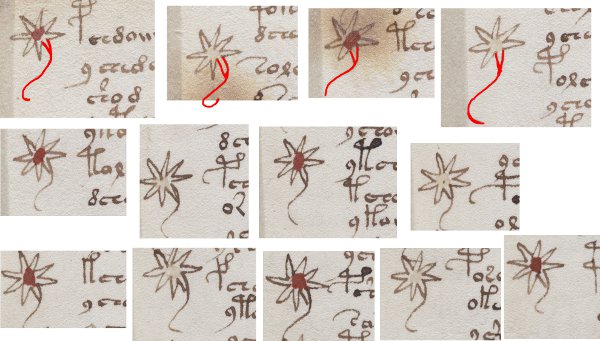I’ve long wondered about what’s going on in the Voynich Manuscript’s final (and, many think, ‘boringest’) quire, Quire #20: I summarized a lot of current Q20 research here last month. But just what Q20’s paragraph markers – whether they turn out to be stars, comets, or flowers – are remains a mystery… basically, why are they there at all?
You see, because each star sits at the start of a paragraph and (as Elmar Vogt helpfully pointed out) many are arranged on pages in what seem to be repetitive x-o-x-o-x-o patterns, it seems fairly safe to conclude that these are mostly decorative, and hence there is probably nothing much “written in the stars”. Of course, anyone who desperately wants to go a-huntin’ for a biliteral ciphertext hidden there is more than welcome to try (go ahead, feel free to knock yourself out), but I don’t honestly think you’ll squeeze much juice out of that lemon, sorry. And wipe that sour look off your face, OK? 🙂
Yet even so, the brutal fact remains that the paragraph stars are there: and given that pretty much everything else in the VMs mutely screams of carefully-executed disguised intention, I think we should expect there to have been a perfectly good reason for their existence, however mundane that might actually be. So probably the best question to be asking is: what function (however minor) could these stars be performing? What did they help the author(s) do?
Until a few days ago, this was pretty much the brick wall my chain of reasoning had hit: but then I read an interesting post by Rich SantaColoma on the ‘weirdo’ red glyphs on f1r (the very first page of the Voynich Manuscript). In particular, Rich points out the striking similarity between the first “bird glyph” (the first symbol of the second paragraph in the VMs) and marginal paragraph markers in some 16th Century Spanish manuscripts, the Codex Mendoza [1541/2], the Aubin Codex [started in 1567] and the [probably fake!] Codex Cardona, while in the comments to Rich’s page, Ernest also mentioned the Codex Osuna [1565] and the Book of Chilam Balam of Chumayel.
Ultimately, Rich’s reasoning comes down to this: in these Spanish manuscripts, the glyph is simply a decorative “Y”-shape, short for “Ydem”, which is used in lists pretty much the same way as both “item” and “ibidem” (which we still use in its differently-shortened form “ibid.“), so it seems reasonable to infer that this is what’s happening on f1r of the VMs too.
All fair enough: but regardless of whether Rich’s idea turns out to be right or wrong (and it’s desperately hard to build up a really convincing case on a single instance of a single shape), what struck me most was the parallel between the paragraph stars and these similarly itemized lists. (But no, I’m definitely not proposing that Q20 is a Powerpoint presentation from the Renaissance).
So… might each star simply be an embellished / disguised “y”, short for (say) “ydem” / “ytem” / “idem” / “ibidem” / “item”? Actually, I think yes: look at the following picture (which contains all the paragraph stars from f104v), and I’ll show you how I think the “y” was hidden in the first four stars (highlighted in bright red), make up your own mind for the rest:-
Now tell me the second best explanation for these! And yes, I do know that some of the (probably later) pages in Q20 have tail-less stars, but the basic hidden-in-plain-sight steganographic conceit was probably getting a bit boring by then, 300+ stars later. 🙂

